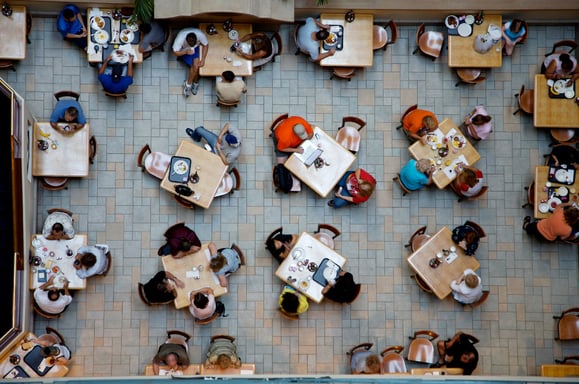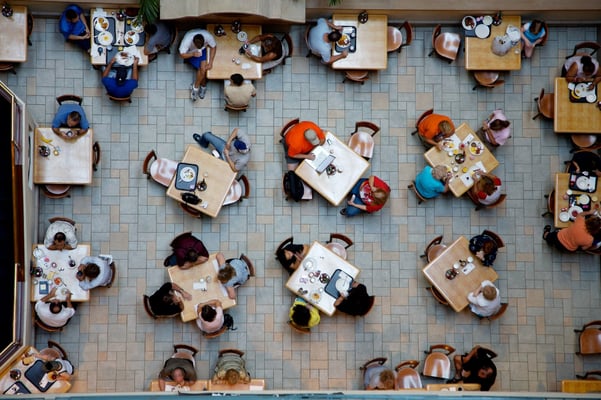As healthcare has changed, innovated, and modernized, so has the nutrition services accompanying the industry. Continuous improvements with an eye on consumer trends and preferences have created the ultimate experience in healthcare dining. What are some of the overarching themes affecting the positive momentum across health and medical campuses?
Even the term cafeteria seems institutional and sterile; today the words cafe, bistro, restaurant, and food court have replaced the antiquated version of cafeterias. Aside from the entrance and registration, cafes are the most communal space of hospitals and healthcare campuses.
I sat down with Brian Disch, Purchasing Supervisor at Park Nicollet Methodist Hospital in St. Louis Park, MN to discuss the topic of healthcare and nutrition. It's been a busy 2019 for the nutrition services team at Methodist as renovation of its campus including the cafeteria, Creekview Cafe, which opened in May. Methodist Hospital is a 426-bed campus with 3,000 employees; 2,500 people a day are served through dining services. About 75 percent of the cafe's daily guests are hospital employees while the remaining 25 percent are visitors.
Everyone is a Foodie
Brian has been with Park Nicollet Methodist in dining services for over 20 years. "The biggest thing I've seen in my career is now, everyone is a foodie. People watch Food Network and other TV shows and just have a wider perspective on food in general. They now have certain things they want to try or see available wherever they go. And, when I say everybody that's a little extreme. But a lot of people have different expectations about food than they did 10 or 15 years ago. Before, you could just serve meatloaf and mashed potatoes and everyone was happy. It was warm, it was available, and it was comforting in a healthcare setting. We still serve comfort food, just not every single day like we used to," he said.
Food is our one great unifier. Nothing brings people together like sharing a cup of coffee or meal together. The general topic of food has evolved into an experiential, hobbyist form of expression thanks in part to exposure (as with food-based TV series as Brian mentioned) as well as an overall generational shift. Nutrition and dining services in healthcare is continually raising the bar on what's being offered onsite for food and beverage options.
Better Eating Collaborative

At the core of healthcare is health itself. Emphasis on healthy eating and wellness is also being supported by dining and nutrition services in terms of what’s being offered to consumers. Healthy food and beverage policies began cropping up in hospitals and healthcare facilities the past decade, many programs seeking to eliminate sugar-sweetened beverages from cafes, vending machines, patient rooms, and dining rooms. No Sugar Added beverages feature five calories per serving with two grams of sugar. Other changes include juices that previously were comprised of 60 percent juice now are 100 percent, and offering a wider range of beverages including sparkling and enhanced water.
"One of our biggest increases in sales over the past year has come from LaCroix and bubly sparkling water. Flavored water in cans and 20oz. bottles are huge here," Brian explained. He also listed other healthier alternatives Park Nicollet Methodist offers employees and guests like unsweetened iced coffee, matcha green tea, sugar-free energy drinks, and Bubbl'r.
Methodist has a better eating collaborative that combines efforts of staff dietitians, physicians, and the nutrition services team to ensure the hospital continues to drive initiatives and efforts focused on wellness and healthy choices in food and beverage services.
Made to Order & Customization
Hospital food used to be about serving the masses. Serving the masses quickly and efficiently and that model of service worked — until it didn't. Just as consumer preference shifted in how and why they wish to seek dining options in typical establishments like restaurants and bars, it transcended all landscapes of food and beverage. The methods and customization people have come to expect anywhere they can order a meal, snack, or beverage are now also the expectation even at the coffee cart in the corridor of a hospital.
"Colleges and universities are the ones usually on the cutting edge of innovation and trends in dining services. Keeping college kids happy is a different model than a lot of industries who serve a wide-range of the population, like healthcare. Yet the younger generation is accustomed to the service and offerings of college campuses as they make their way through other areas of life. Other industries including ours have to recognize what the millennials mean for customization and options," Brian added.
Made-to-order offers a freshness and immediacy in tandem for a better dining experience. Creekview Cafe rotates its daily exhibition offerings to include a different cuisine theme. Options include:
- Curry
- Asian Stir-fry
- Pasta
- Fajita
- Sausage Bar
Last fall, Brian and team hosted an Indian food pop-up to generate awareness and excitement for a new cuisine offering samples of chicken tikka masala, Punjabi beef, and grilled tandoori chicken sandwiches to cafe guests.
Efforts to Reduce Waste
The topic of consumption and waste is a hot one in 2019. If everyone does their part, including giant healthcare facilities, change can happen. Brian summarized it best by saying, "If someone is ordering it, they're probably eating it." Park Nicollet Methodist also serves about 250 patients per meal via in-room dining, three times a day. Patients choose menu items and select times of day to be served breakfast, lunch, or dinner. As one of the early adopters in the metro area to choose room service-style patient meals, Methodist has been able to drastically reduce food waste by tailoring how and what hospital guests choose for meals.
In 2018, the hospital added an organic waste food compactor that better handles the disposal of food and packaging waste. Brian's team tracks waste reduction by menu cycle to add clarity and forecasting to the department. He explained how to maximize menu items by being diligent with resources to reduce waste and keep costs lower for the business and the consumer. "When we feature a build-your-own sausage bar, the next day we can feature a chef's choice daily feature like a pasta bake to allocate the excess prep our team did for the sausage bar."
What's the future of healthcare-based dining? Brian forecasts more of the same. "Healthy, on-trend options."




